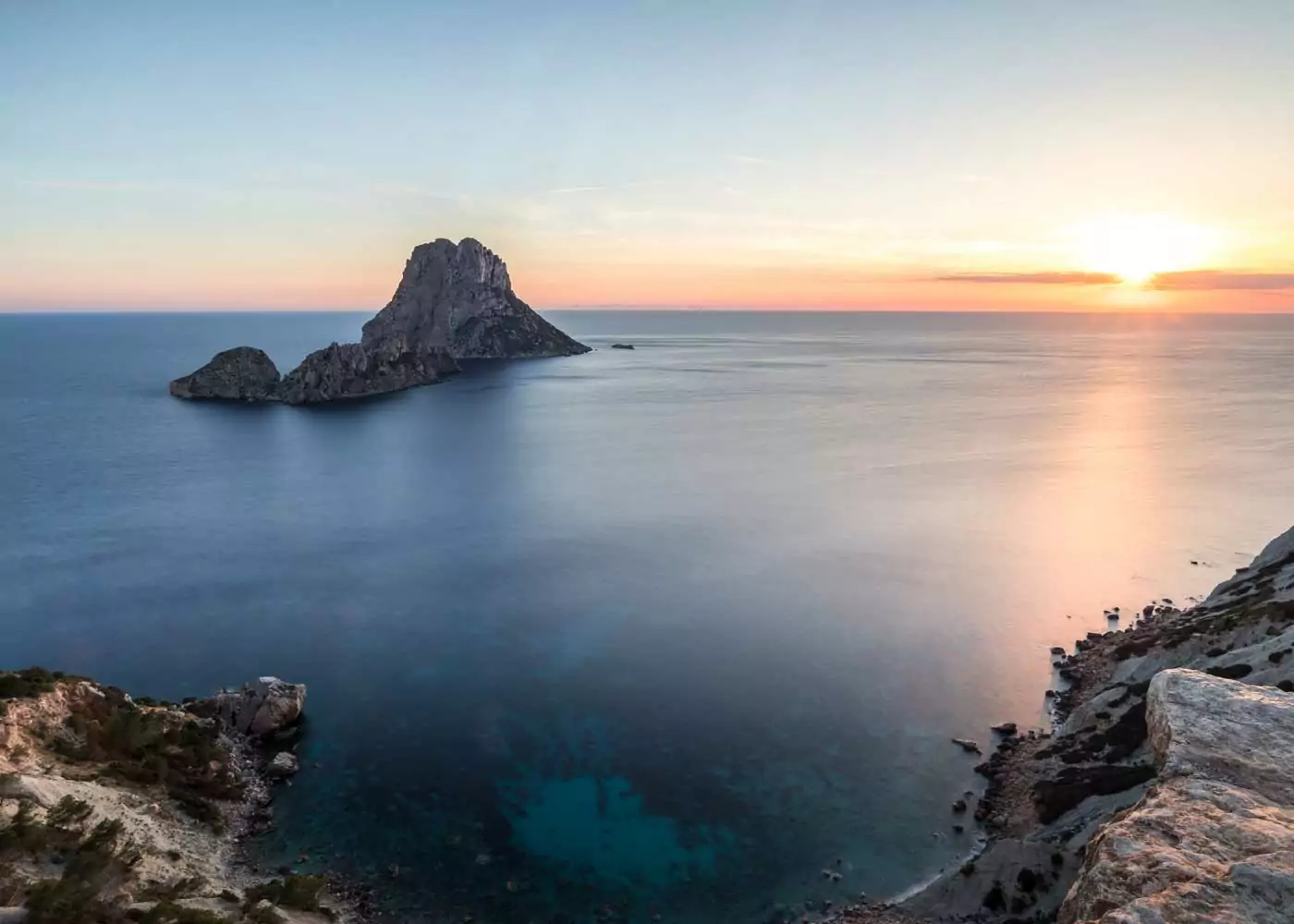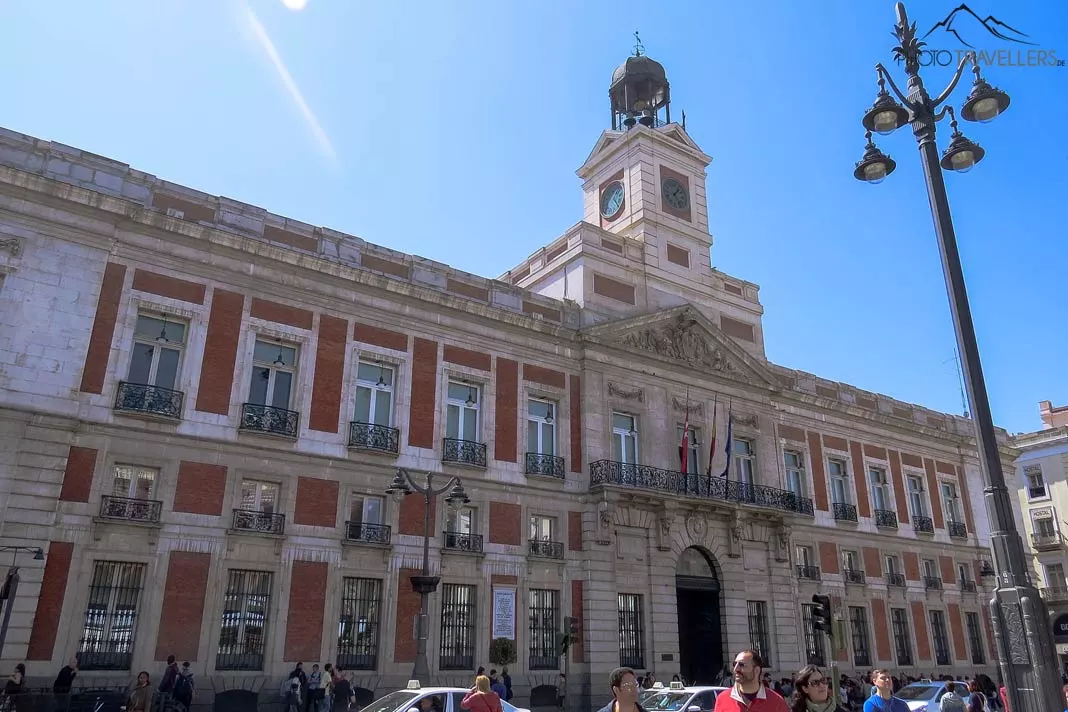
Top things to do in Madrid: 15 beautiful sights to see [+ map]
When you hear Spain, you might first think of paella, sangria, beach, and sea - typical for Mallorca, Barcelona, or Valencia, for example. A trip to the capital Madrid often seems to be interesting only for soccer fans and art enthusiasts thanks to Real Madrid and the many museums.
But Madrid has a lot to offer and is definitely one of the most beautiful vacation destinations in Spain. In this article, I present to you the most popular sights in Madrid.
I'll also give you some real insider tips and show you some secret places, so you can experience Madrid not only as a tourist but also from the perspective of the Madrileneans.

Hi! Wir sind Biggi & Flo
Wir nehmen dich als Reisejournalisten mit zu den schönsten Orten der Welt!
Werbehinweis: Alle mit einem * markierten Links sind Werbelinks.
The Top-10-sights in Madrid in an overview
We tell you the top attractions, the most popular neighborhoods, the most beautiful beaches, the coolest places to chill but also really good restaurants and beautiful hotels in Madrid.
You want to know what to do in Barcelona? Then come with us to one of the most exciting cities in Europe. For now, here are our top 10 sights in Madrid at a glance.
- Puerta del Sol
- Plaza Mayor
- Mercado de San Miguel
- Königspalast Palacio Real und Almudena-Kathedrale
- Tempel von Debod und Plaza de España
- Gran Vía – die Straße, die niemals schläft
- Stadtviertel Malasaña, Chueca, La Latina, Barrio de Las Letras, Barrio de Salamanca
- Bellas Artes – die wohl bekannteste Dachterrasse der Stadt
- Plaza de Cibeles
- Retiro
Map: All sights in Madrid
In our interactive map, you can find all sights in Madrid at a glance. Have fun discovering the most beautiful places to go in the metropolis.
[mapsmarker map=”263″]
1. Puerta del Sol

Our little tour starts in the heart of the city center: the Puerta del Sol, roughly “Sun Gate” in English. The name derives from the fact that a gate with a sun was used to decorate the eastern entrance to the square.
There stands the Real Casa de Correos, originally the Royal Post Office and now the seat of government of the Autonomous Community of Madrid. The building’s clock is of central importance on New Year’s Eve: with each of its twelve chimes, which are broadcast on television, Spaniards eat a grape at midnight.
In front of the Government Building, there is also the zero kilómetro 0, the starting point of the most important roads in Spain.
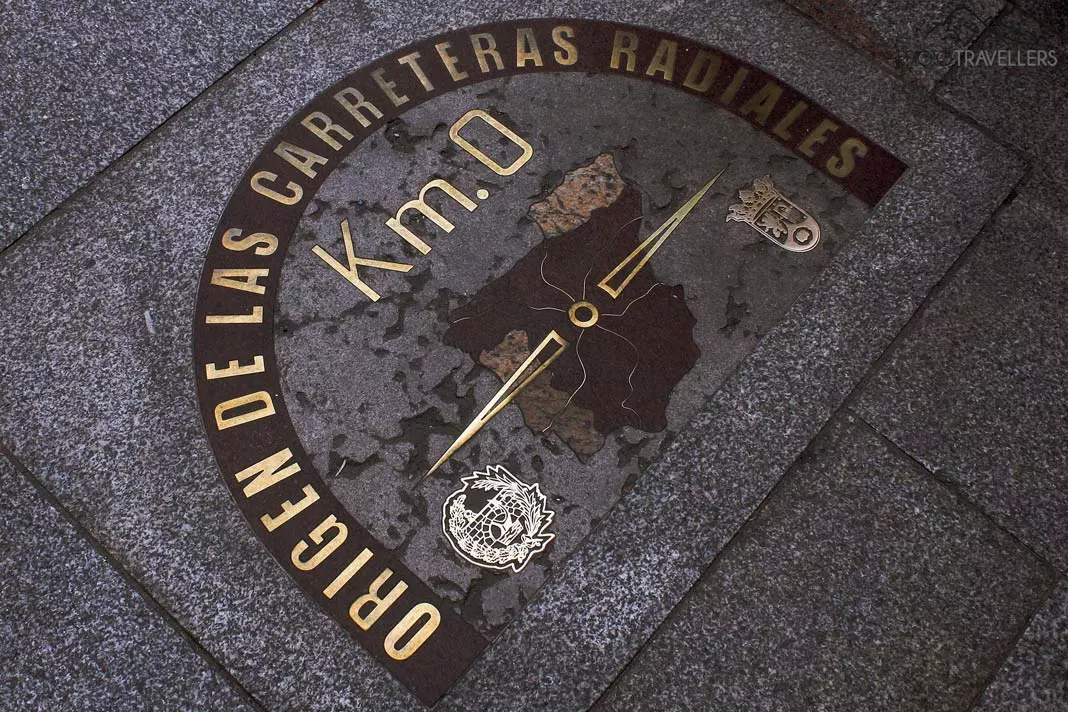
On the Puerta del Sol you will also find Madrid’s emblem: the statue El oso y el madroño was made by Antonio Navarro Santa Fe and shows a bear (oso) and a strawberry tree (madroño). There are several theories about its meaning but it’s believed to symbolize the unity between clergy – represented by the tree – and nobility – represented by the bear.
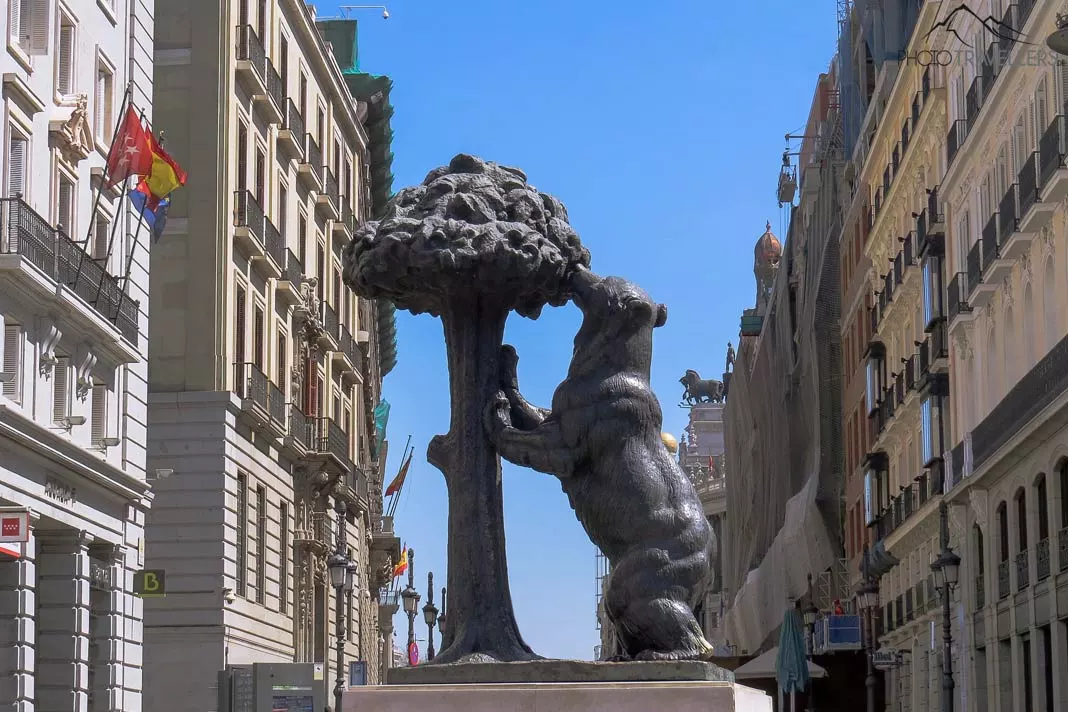
Tip: What to see in Madrid you can explore easily with Go City Pass Madrid (order here*).
2. Plaza Mayor
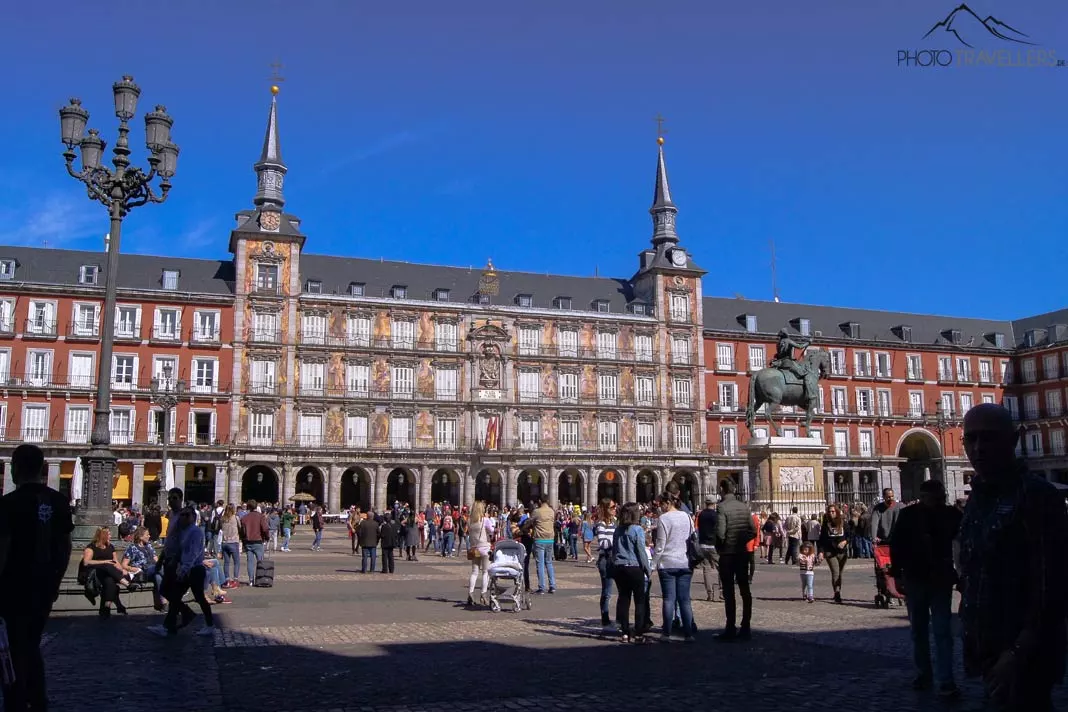
Plaza Mayor is another top thing to do and means the main square. It’s surrounded by residential buildings with a total of 237 balconies and has nine entrances. What to do in plaza Mayor? Around the square are archways with small stores and restaurants.
But beware: it’s quite expensive here and clearly aimed at tourists, a real Madrilenean would hardly settle here. However, the best bocadillos de calamares (a sandwich with squid rings, typical of Madrid) are said to be at the Casa Rúa bar, located just after the exit to Calle de Ciudad Rodrigo.
On the north side of the square is probably its oldest and most famous building, the Casa de la Panadería, the House of the Bakery. Later, the house of the butchery, the Casa de la Carnicería, was built opposite it. The statue in the center of the square depicts King Philip III, who ruled Spain in the early 17th century and under whose reign the Plaza Mayor was completed, on his horse.
Every Sunday there is a small market in the archways with stamps, old postcards, and coins. Moreover, during the Advent season, there is a Christmas market in the square, and from time to time you can see plays, concerts, or other events there. So you see: there is also a lot to discover at the Plaza Mayor. So this place is definitely one of the most popular activities in Madrid for me.
3. Mercado de San Miguel
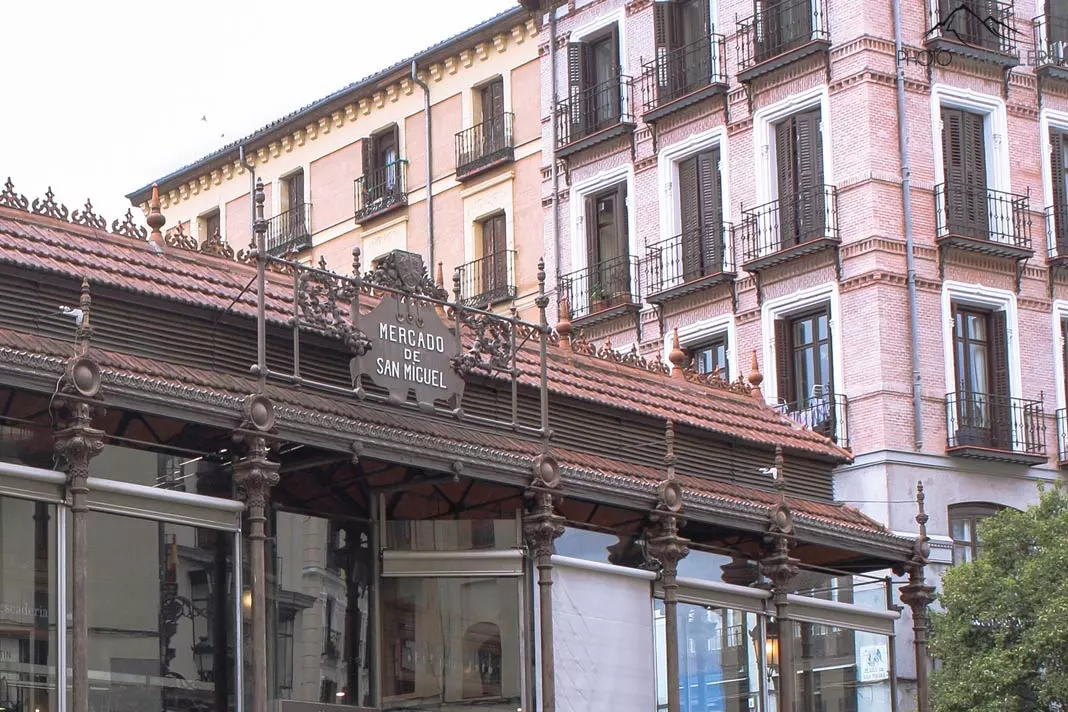
The Mercado de San Miguel is one of the most famous market halls in Madrid and a top thing to do there. With over 10 million visitors per year, it’s also one of the most touristy and expensive. So it’s best to just stroll through and have a look – because the stalls look really great. There is everything from fruit and vegetables to sandwiches, ice cream, and fish to wine, and beer.
Besides, the market hall itself is also very impressive: its iron facade dates back to the beginning of the 20th century. You should definitely make a stop here!
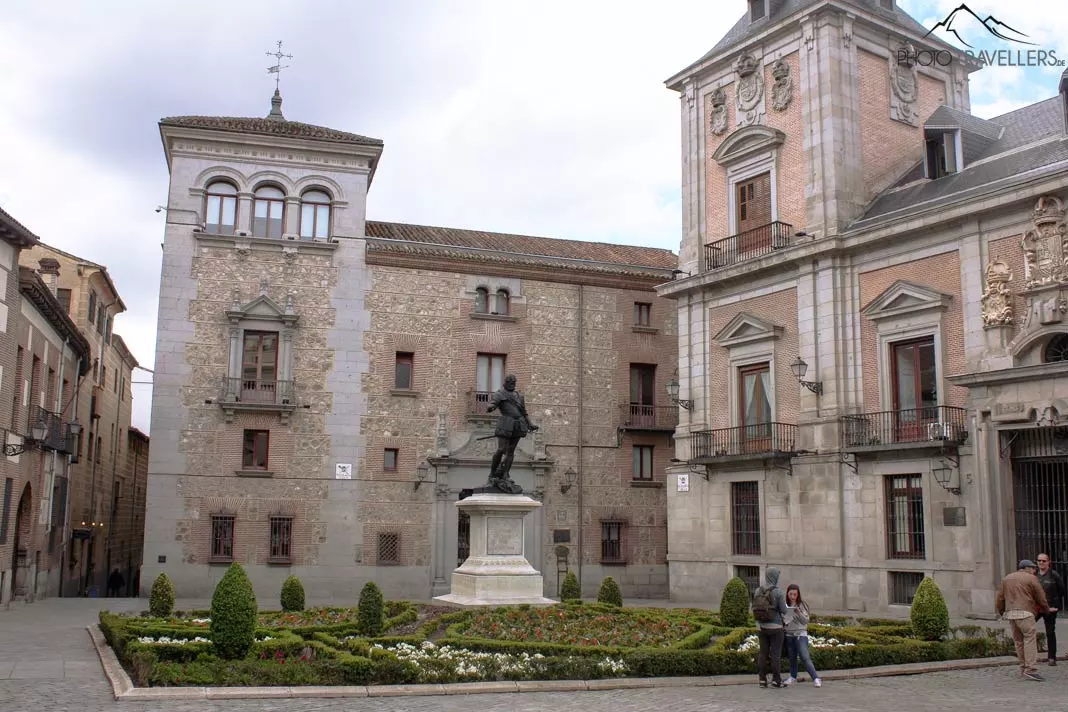
⭐ Recommended travel guides for your Madrid trip
The official website of the tourist board (Website) has extensive information, making it a great place to plan for your city trip. To complement this, one of these guidebooks is ideal! You just have to check out Fodor’s Madrid: with Seville and Granada (get it here*). And of course, what you should also take a glimpse in is DK Eyewitness Top 10 Madrid (buy now*).
4. Royal Palace and Almudena Cathedral
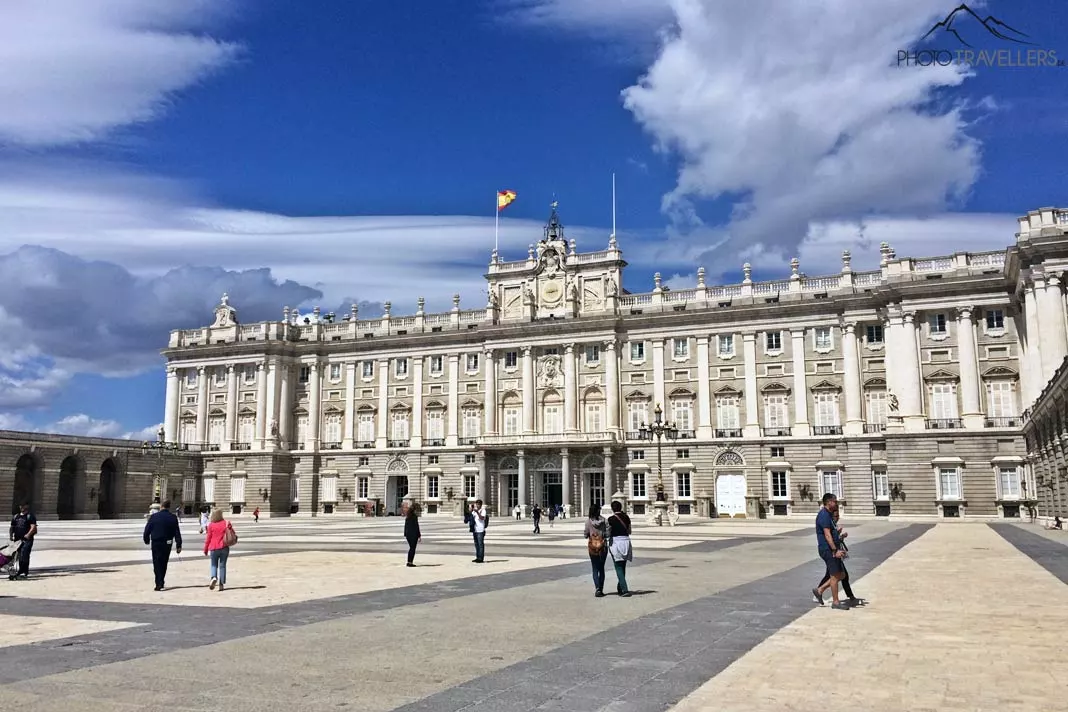
The Palacio Real, or Royal Palace, is the official residence of the Spanish royal family and is, of course, one of Madrid’s most famous sights to see.
However, the royal family does not live there and the palace is only used for special occasions and events. You can tell if the king is there by the fact that there are two flags – instead of just one – flying on the roof of the building.
The Palacio Real consists of 3.418 rooms and is one of the top things to do in the metropolis. So if you wanted to spend just one night in each of them, you would need more than five whole years! Some of the halls are open to the public, but admission costs between 11 and 13 euros. At certain times, access is free but then you have to expect very long lines (website). Personally, I would rather admire the palace only from the outside – the palace park is also very worth seeing and free of charge.
Opposite is the Catholic Almudena Cathedral, which was only completed in 1993. It was built in neoclassical style and is very modern. Its interior was designed by painter Kiko Argüello in a pop art design. The current Spanish King Felipe and his wife Letizia were married there in 2004. Admission is free but a small donation is still appreciated.
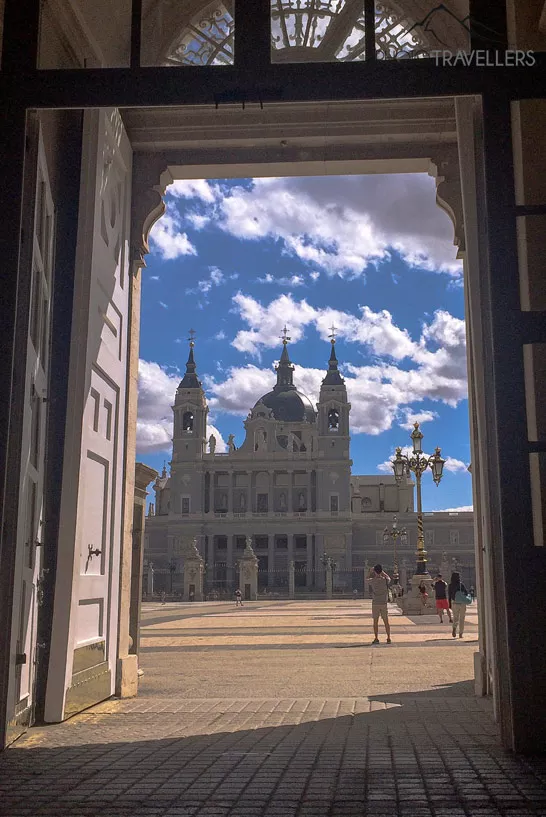
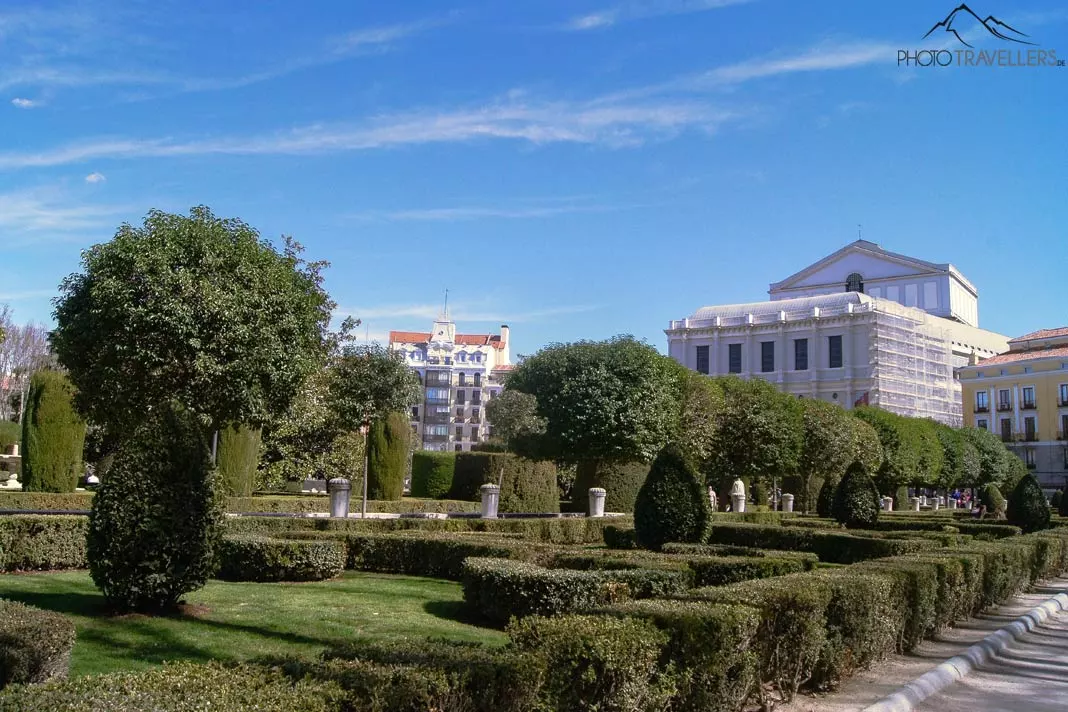
5. Temple of Debod and Plaza de España
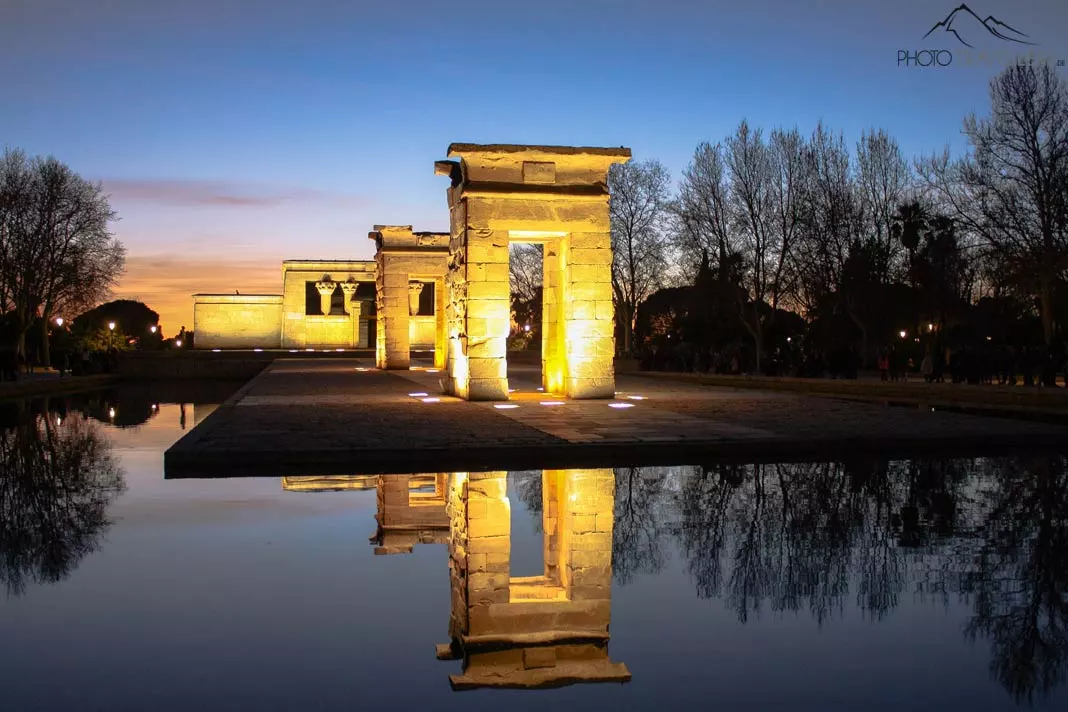
The Temple of Debod, Templo de Debod, is an Egyptian temple that originally stood at Debod on the west bank of the Nile. The Egyptian government gave it away to Spain in 1968 to save it from flooding. The temple of Debod was rebuilt in Madrid on a former site of military barracks and has been open to the public free of charge since 1972. It’s worth a short visit! In addition, from the location of the temple, you can see one of the most beautiful sunsets in Madrid, which unfortunately is also no longer an insider tip.
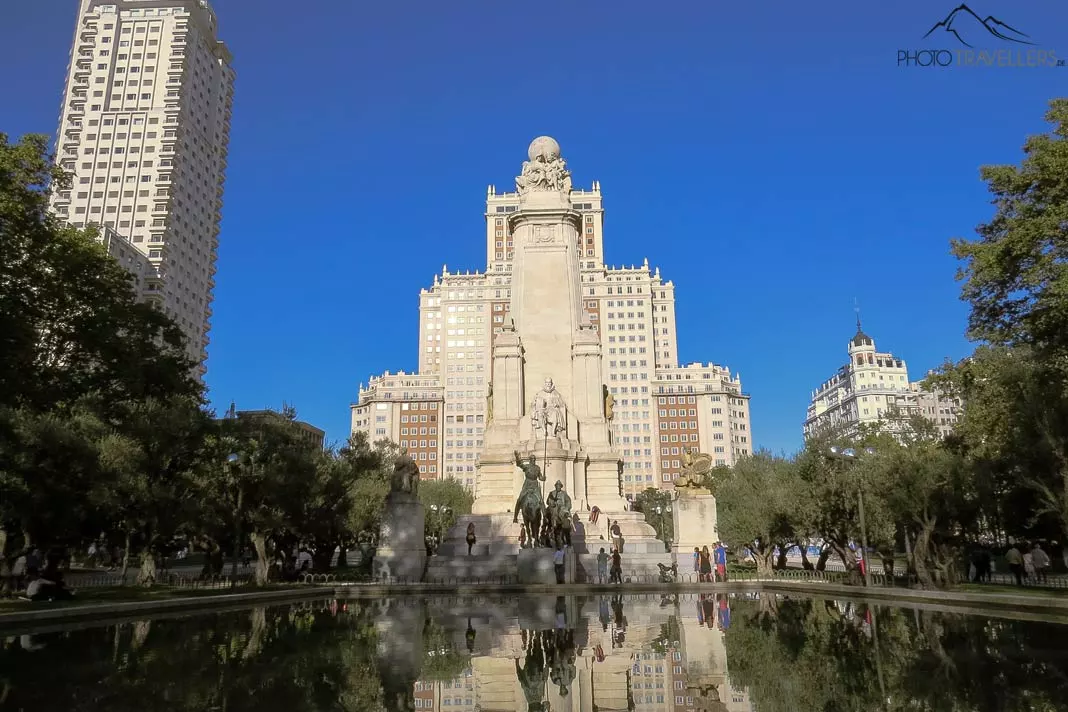
Not far from the temple of Debod is the Plaza de España with the two prominent high-rise buildings Torre de Madrid and Edificio España. In the latter, a luxury hotel with two swimming pools is currently being built. In the center of the square is a monument depicting the Spanish poet Miguel de Cervantes looking down on his two famous novel characters Don Quixote and Sancho Panza.
6. Gran Vía – the street that never sleeps
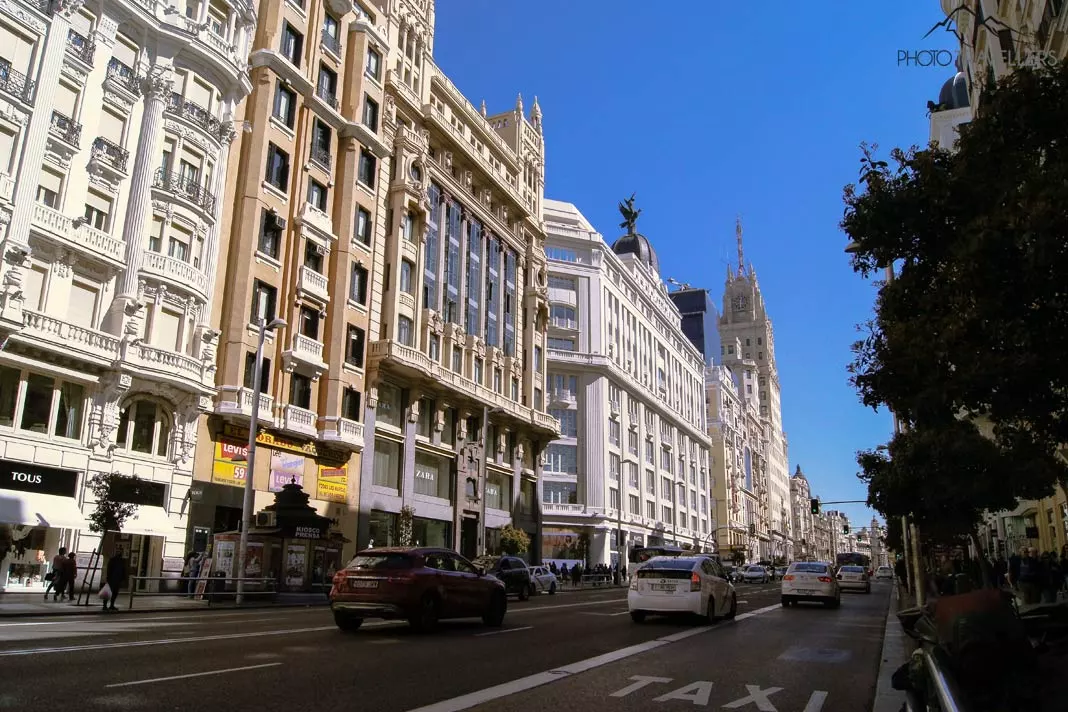
The Plaza de España is also one of the two endpoints of the famous Gran Vía, in English Great Street. It’s one of the most famous shopping streets in Spain and is one of the absolute highlights of the city.
In its center is the Plaza de Callao, where, among other things, stands the Edificio Capitol, also known as the Schweppes building because of its large neon sign. By the way, the best view of this building is from the ninth floor of the mega department store Corte Inglés.
From Gran Vía – where you can not only store, party, or go to the movies but also watch musicals like The Lion King – branches off Calle de Fuencarral, another long shopping street.
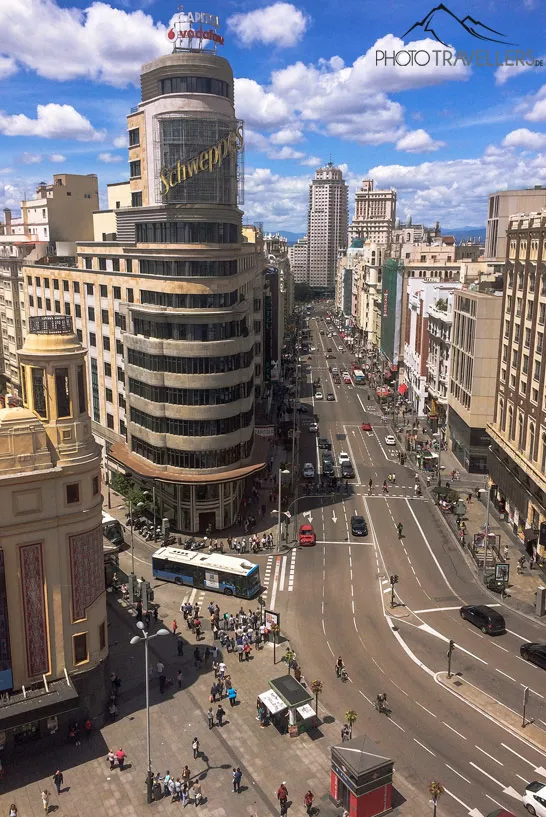
Tip: The Schweppes building is home to the Hotel Vincci Capitol, among others, from whose roof terrace you have a great view of Gran Vía!
7. The different quarters of the city: Malasaña, Chueca, La Latina, Barrio de Las Letras, Barrio de Salamanca
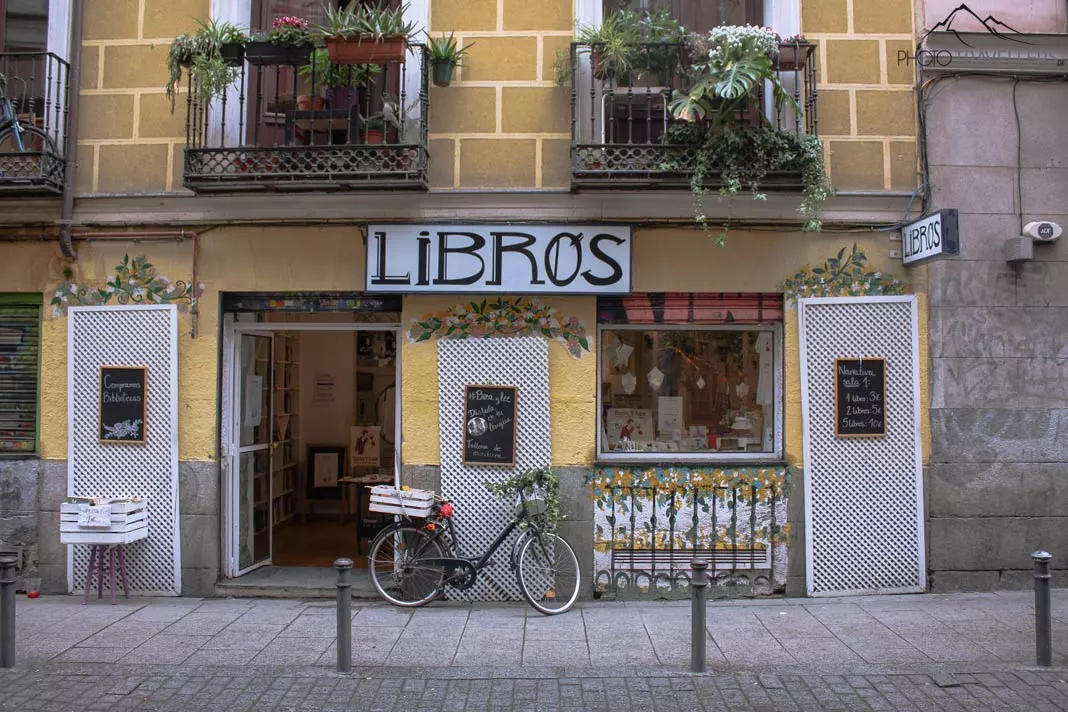
The most beautiful barrios – that’s what the neighborhoods are called in Spanish – are scattered throughout Madrid, all special in their own way and all well worth visiting.
The central hipster neighborhood of Malasaña scores with lots of restaurants, cafes, and stores, while the adjacent gay and lesbian neighborhood of Chueca is a hive of activity day and night. La Latina, supposedly the most Madrilenian neighborhood, and the poets’ district Barrio de las Letras are also in the center, as is the Lavapiés neighborhood, known as a melting pot of cultures and home to many Indian restaurants.
A little further away to the northeast is the chic Barrio de Salamanca, where one designer store follows another. These are just a few examples of Madrid’s diverse neighborhoods – it’s best to just drift and explore the city’s alleys on your own.
8. Bellas Artes – probably the most famous roof terrace in the city
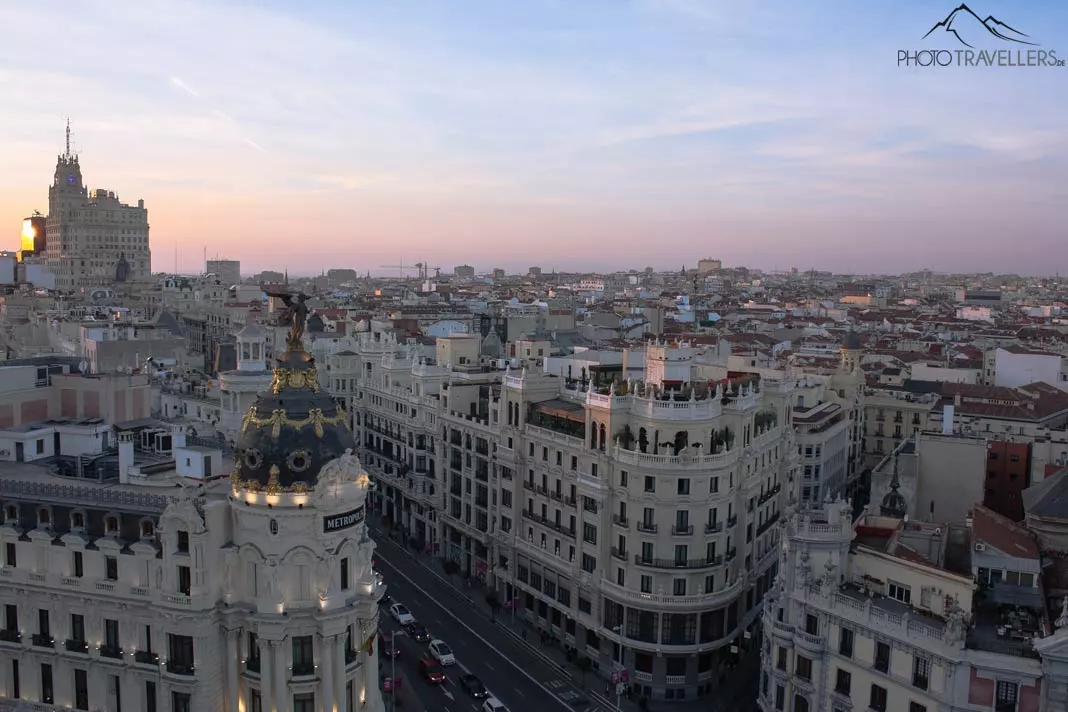
The Círculo de Bellas Artes – in English, the Circle of Fine Arts – is a private Madrid cultural institution that organizes exhibitions, concerts, award ceremonies, and the like.
The organization’s main building, located at the end of Gran Vía, has one of Madrid’s best rooftop terraces. Admission is 4 euros and drink prices on the terrace – where there’s even a restaurant – are steep. But the view is definitely worth it!
Other great rooftop terraces are offered by various hotels, for example, the Hotel de las Letras in Gran Vía with its Ático 11 and the Dear Hotel Madrid near Plaza de España with a terrific swimming pool, which is unfortunately only open to hotel guests. Also worth a visit are, for example, the terraces of the Gymage Lounge Resort fitness club near Gran Vía and the Mercado Barceló near the Tribunal metro station.
9. Plaza de Cibeles
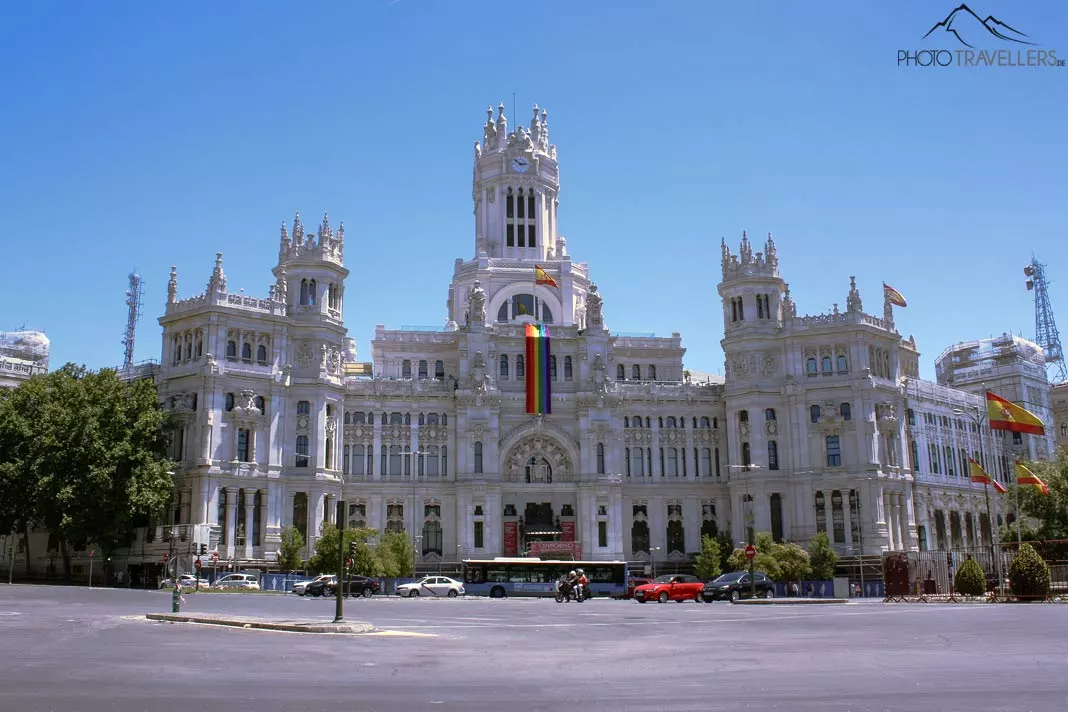
In the center of Plaza de Cibeles is the 18th-century Fuente de Cibeles fountain, dedicated to the Greek goddess of fertility. Traditionally, Real Madrid celebrates major victories there, while Atlético de Madrid does so in Plaza de Neptuno, which is just a bit further south.
Also in the square is the imposing Palacio de Cibeles, which used to serve as the main post office and has been the seat of the city government since 2007. It is also a cultural center, which is freely accessible. A restaurant on the 6th floor with a roof terrace and a viewpoint on the 8th floor are also part of the building. The glass-roofed courtyard is architecturally very interesting and worth seeing.
Tip: For night owls, the Plaza de Cibeles could also be of importance. From 2 a.m., when the metro stops operating, all the night buses – called búhos, in English owls – leave from here.
10. Retiro
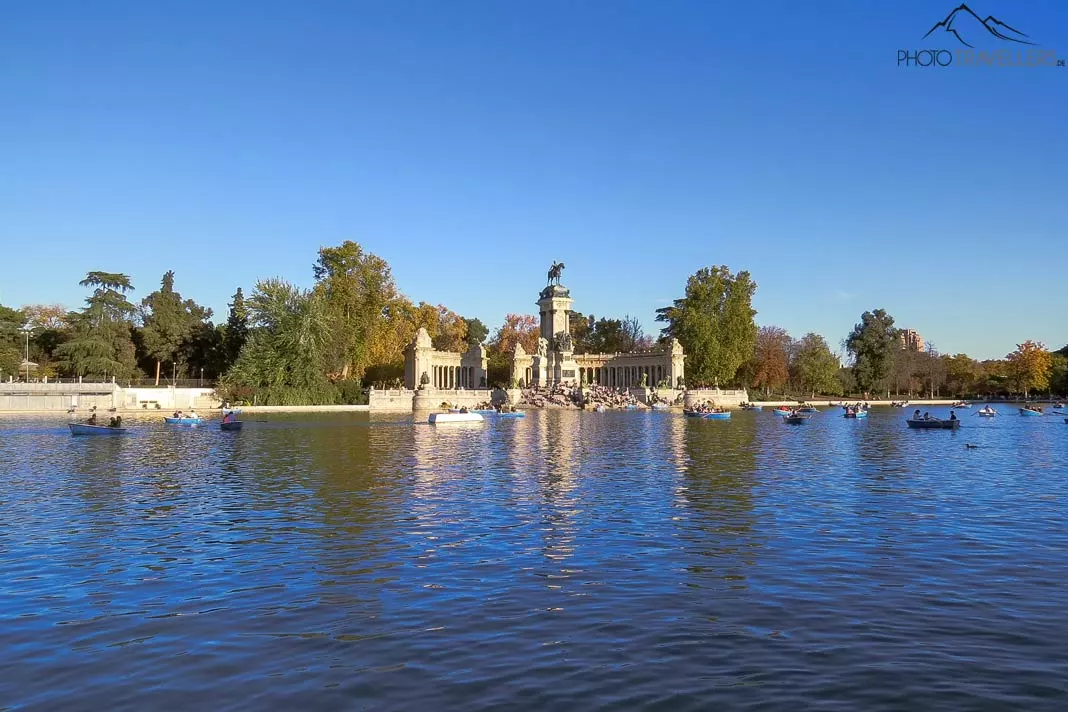 Boats on the lake in the Parque del Retiro. In the background you see the statue of Alfons XII
Boats on the lake in the Parque del Retiro. In the background you see the statue of Alfons XII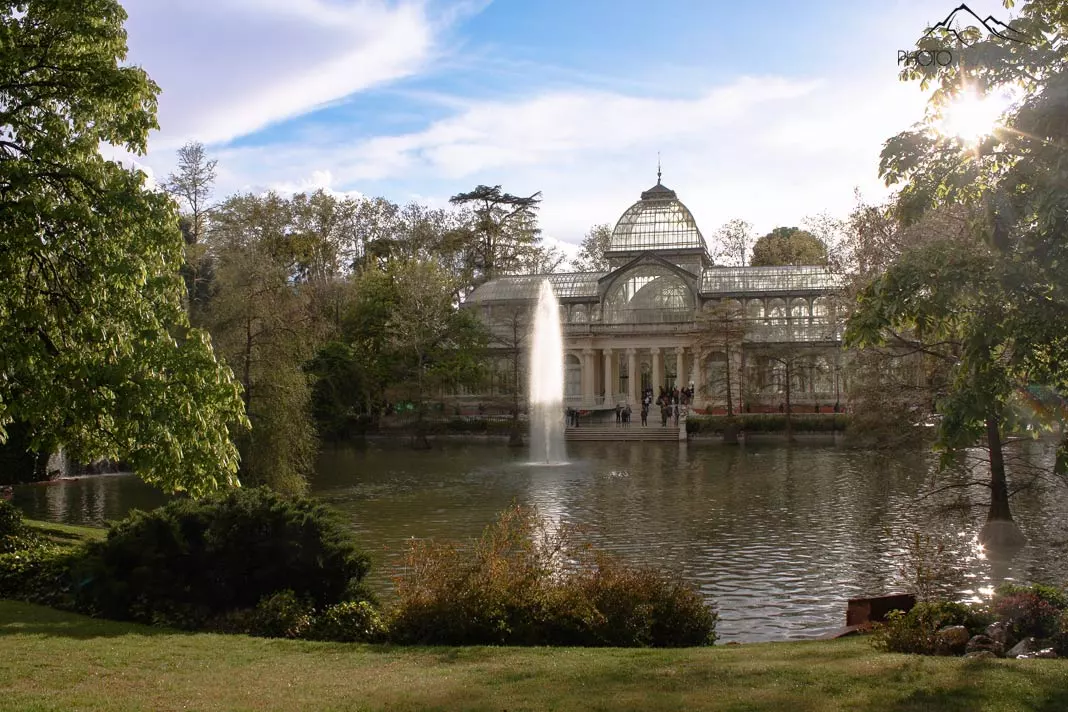 The Crystal Palace in the Retiro Park is a must-do in Madrid
The Crystal Palace in the Retiro Park is a must-do in MadridMadrid has a surprising number of green spaces – one of the largest is the Parque del Buen Retiro, or Retiro for short, with over 15,000 trees. The main entrance to this top sight is near Puerta de Alcalá, a large 18th-century archway. The park is ideal for escaping the hustle and bustle of the city and enjoying a moment of tranquility. Retiro even translates roughly as retreat or refuge.
But the Retiro also has a lot to offer: for one thing, there is the large artificial lake against the backdrop of an imposing monument to Alfonso XII, where you can rent a rowboat and cruise around in the summer (definitely recommended!).
Then at the other end, there is La rosaleda, a beautiful little rose garden. In between is the famous Palacio de Cristal, a glass building modeled after London’s Crystal Palace, where there are always various small exhibitions to admire. And there’s plenty else to discover in the Retiro, too – so it’s not wasted time at all to just stroll around a bit and enjoy the park.
Beautiful parks in Madrid
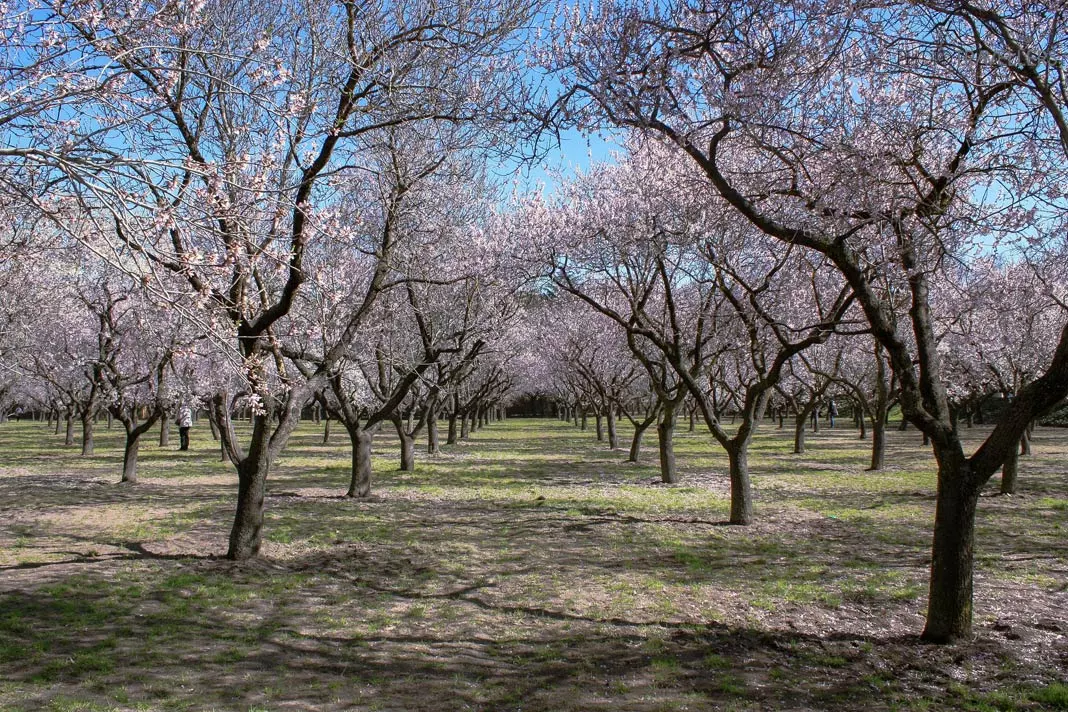
Besides the Retiro, there are quite a few other beautiful parks in Madrid. If you are in Madrid at the time of the almond blossom in February and March, you have to visit the Parque Quinta de los Molinos, which is located at the metro station Suanzes on the green line 5. There are countless almond trees and little green parrots there!
Madrid’s largest park is called Casa de Campo – one way to get there is on the Teleférico, a cable car that leaves near the Argüelles metro station. A single ride costs 4.50 euros, a round trip 6 euros.
The Parque Madrid Río is located directly along the Manzanares River – which is not so much a raging river as a small stream – and is also great for jogging, inline skating, or cycling.
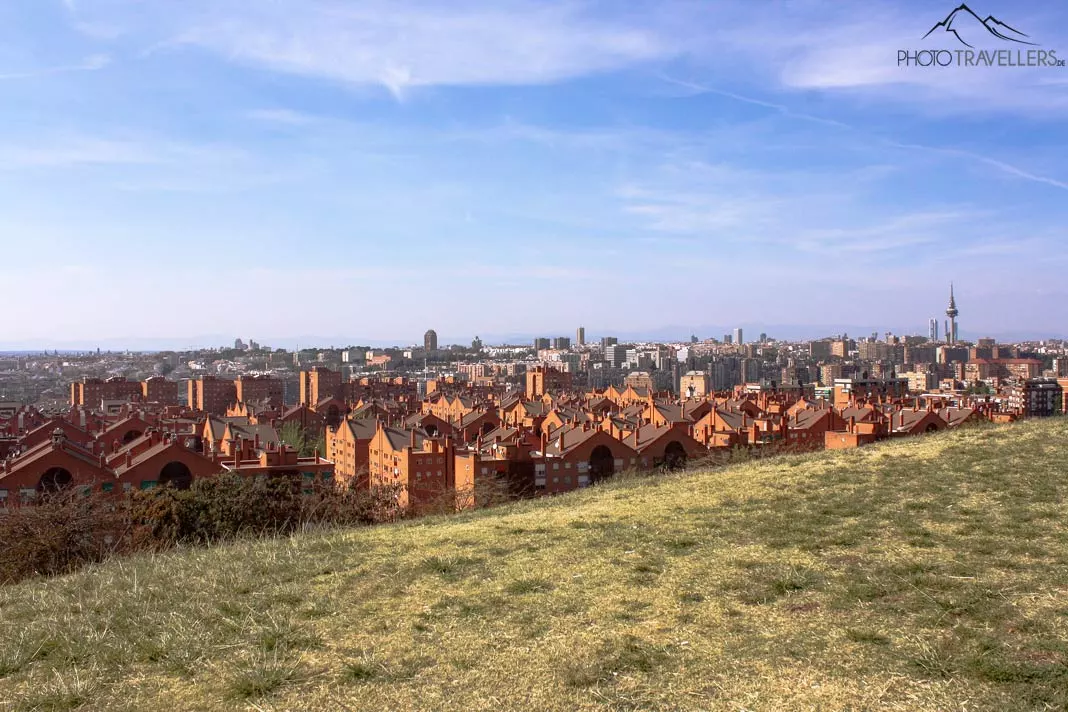 View of Madrid from Parque del Cerro del Tío Pío – a real insider tip for your Madrid trip
View of Madrid from Parque del Cerro del Tío Pío – a real insider tip for your Madrid trip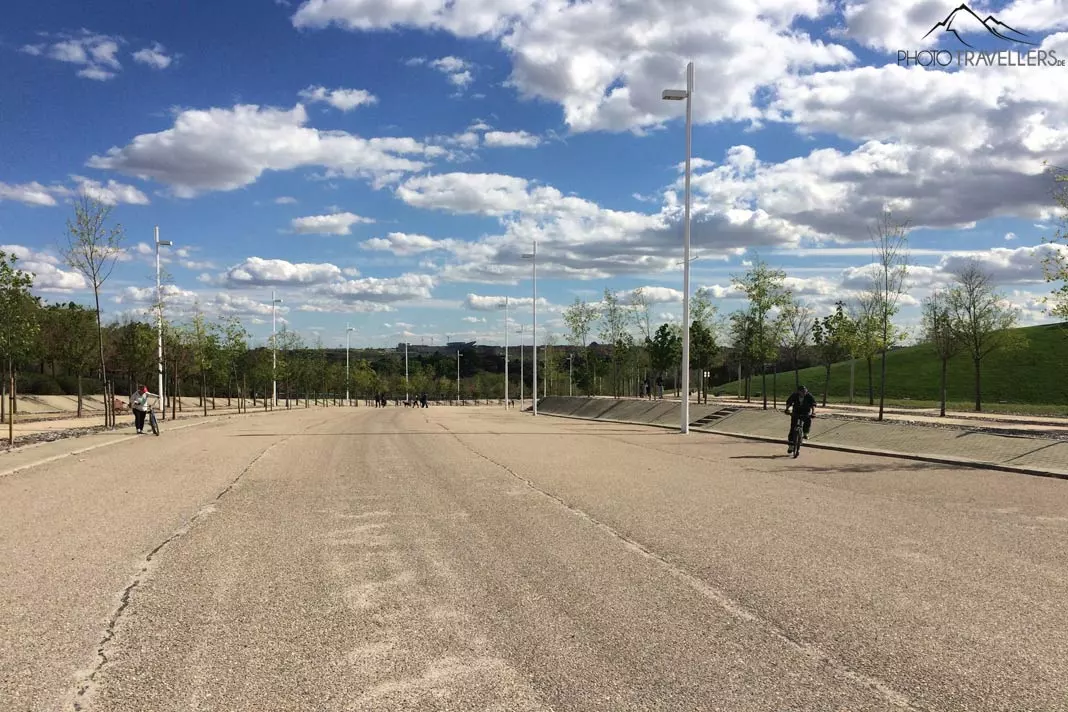 Cycling in the Parque Juan Carlos I – there are many exciting sights here
Cycling in the Parque Juan Carlos I – there are many exciting sights hereThe Cerro del Tío Pío park in the Puente de Vallecas district is also called the Parque de las Siete Tetas (Park of the Seven Breasts) because of its hills. From here you have a great view of the city.
Tip: In the Parque Juan Carlos I, a sculpture park near the metro station Feria de Madrid, you can rent bikes for free after registration – for one hour and as long as supplies last. Be sure to bring your ID to sign up!
Madrid in the rain – this is what you can do
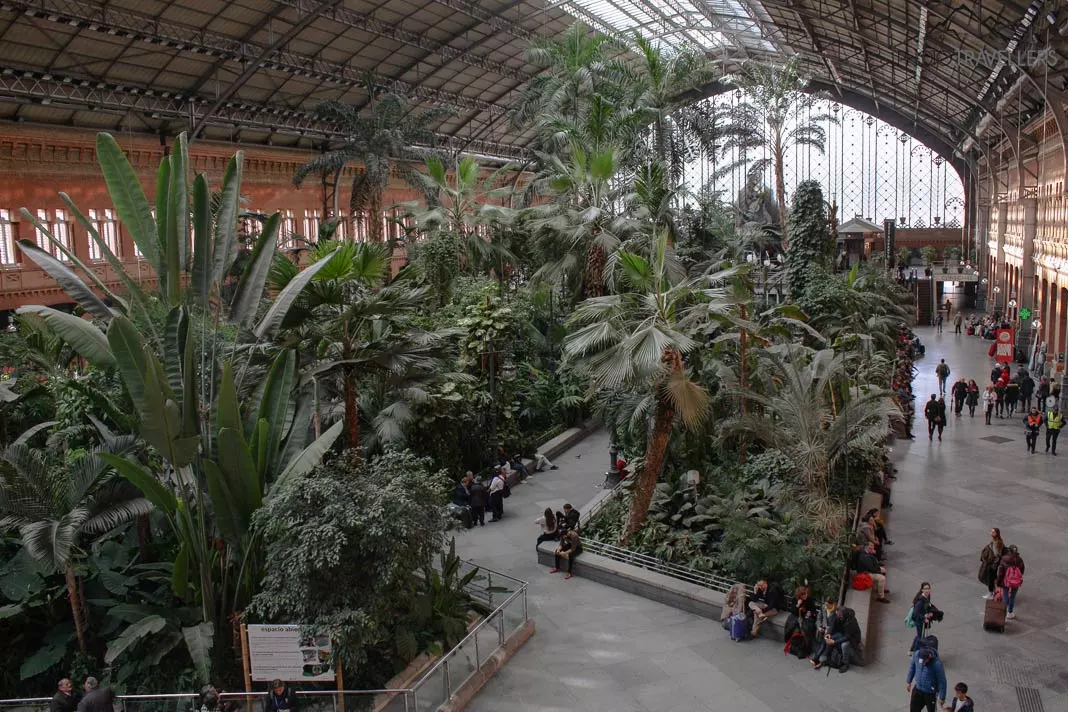
Yes, also in Madrid it can rain sometimes. But don’t panic – there’s plenty to do there too. Take a look at the famous palm garden at the main station Atocha. There is also an impressive memorial to the 2004 Madrid train bombings. Get off at the Atocha Renfe metro station.
A very special experience is the visit to Chamberí, a now-closed metro station from the 1920s. It’s one of two parts of the underground museum Andén 0 (English: platform 0). Between the Bilbao and Iglesia stations of the light blue lines, one also passes through the old Estación de Chamberí but a free visit to the museum is definitely worthwhile.
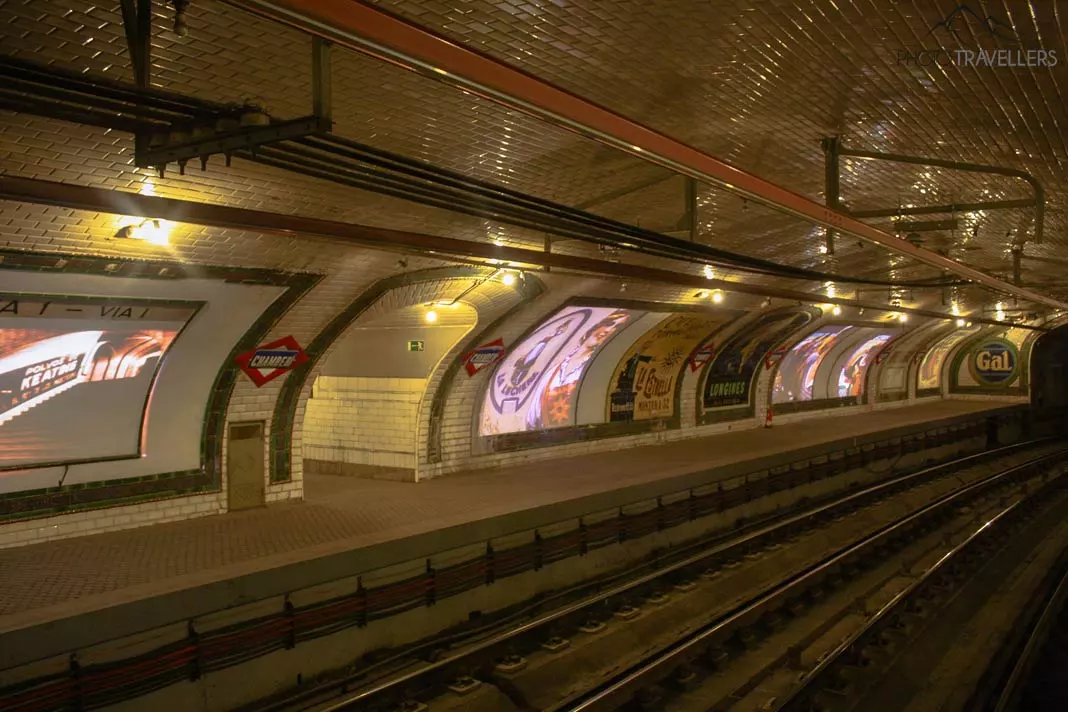
Another tip in case of bad weather is the numerous – admittedly somewhat expensive – market halls where you can eat your way through. These include the Mercado de San Ildefonso on Calle Fuencarral, the Mercado de San Antón in Chueca and the Mercado de Barceló near the Tribunal metro station.
And why not go to the movies in Spain? There’s one of those on almost every corner in Madrid. As well as cute cafés, which can be found especially in Malasaña – for example, the cozy Café de la Luz or the sweet Antorcha Café.
Madrid tips for art lovers
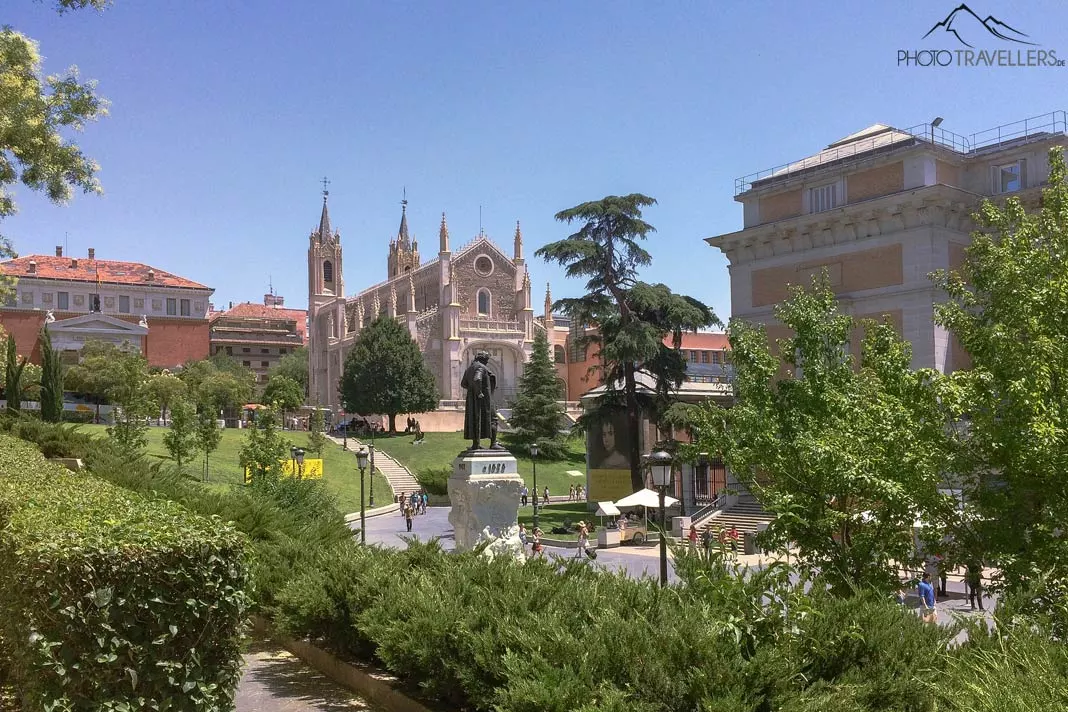
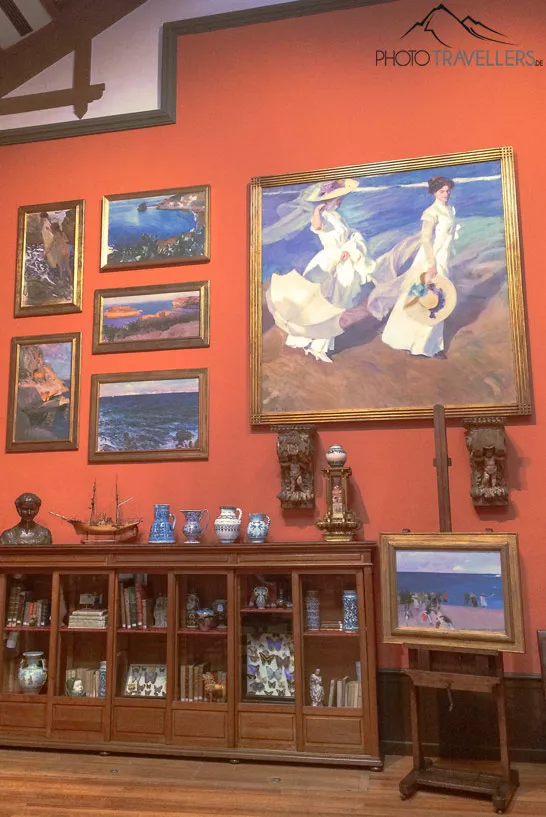
Of course also great in bad weather – a visit to a museum. And there is definitely enough choice in Madrid. Probably the best known is the museum triangle: the Museo del Prado, the Museo Nacional Centro de Arte Reina Sofia, and the Museo de Arte Thyssen-Bornemisza.
In the Prado, there are mainly works of art from the 15th to the 19th century, in the Museo Reina Sofia up to the 20th century, and in the Thyssen, there are even works from the 13th to the 20th century. Especially Prado is very popular but also relatively expensive. Free admission is available there from Monday to Saturday during opening hours from 6 to 8 p.m. and on Sunday from 5 to 7 p.m. – however, a very long line forms at least an hour beforehand.
By the way, right next to the Prado there is a botanical garden, more precisely the Royal Botanical Garden of Madrid. It was already founded in 1755 by King Ferdinand VI and today houses about 5000 different species of trees and plants from all over the world.
The archaeological museum “Museo Arqueológico“, the maritime museum “Museo Naval“, and the “Museo de Historia de Madrid” with the city history are also very popular. My personal favorite, however, is the Museo Sorolla in the northeast of the city center. It’s located in the former home of the artist Joaquín Sorolla, where nearly 1300 of his impressionist paintings are on display.
Madrid tips for soccer fans
What else is in Madrid to do? With no less than three major soccer clubs – Real Madrid, Atlético de Madrid, and Rayo Vallecano – Madrid is a true paradise for soccer fans. The three clubs were founded in this order, in 1902, 1903, and 1924.
Their soccer stadiums form a sort of diagonal from north to south: Real Madrid’s Santiago Bernabéu is located in the relatively central Chamartín neighborhood on the Paseo de la Castellana and holds 81,000 spectators. It was named after a long-time president of the soccer club and can be reached via the eponymous Santiago Bernabéu metro station on the dark blue Line 10.
The Wanda Metropolitano is located in the San Blas-Canillejas district near the airport and only became Atlético de Madrid’s venue in 2017. It can accommodate almost 68,000 people and is also the venue for many concerts and events. Again, the station of the Madrid Metro bears the name of the stadium – Estadio Metropolitano – and can be reached with the orange line 7.
Rayo Vallecano’s small stadium holds just under 15,000 spectators and is located in Madrid’s working district of Vallecas, which can be overlooked by the Parque del Cerro del Tío Pío. To get to the stadium, you can take the light blue line 1 and get off at Portazgo station.
Tip: Be careful with the respective metro lines 10, 7, and 1. When home games take place, it can get very crowded at the beginning and end, even if the metros run more frequently then. It’s best to check the game schedule if you want to take the affected lines.
Madrid culinary: You must try this!
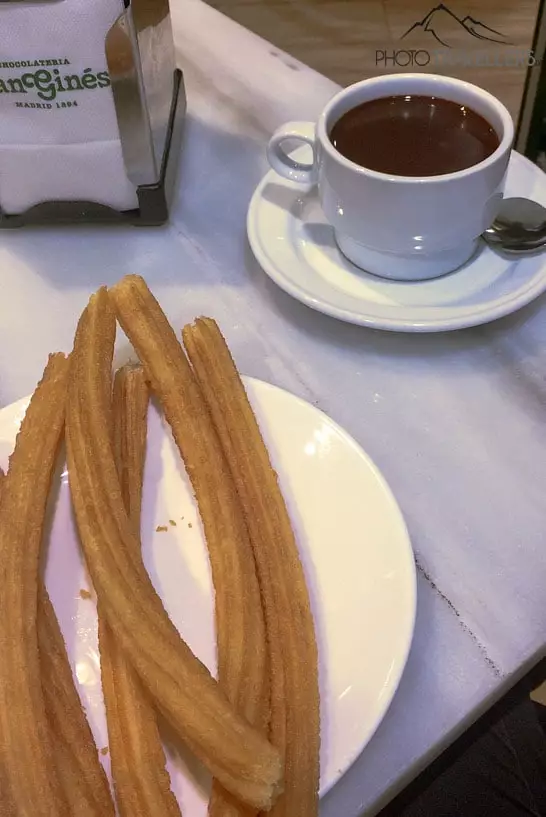
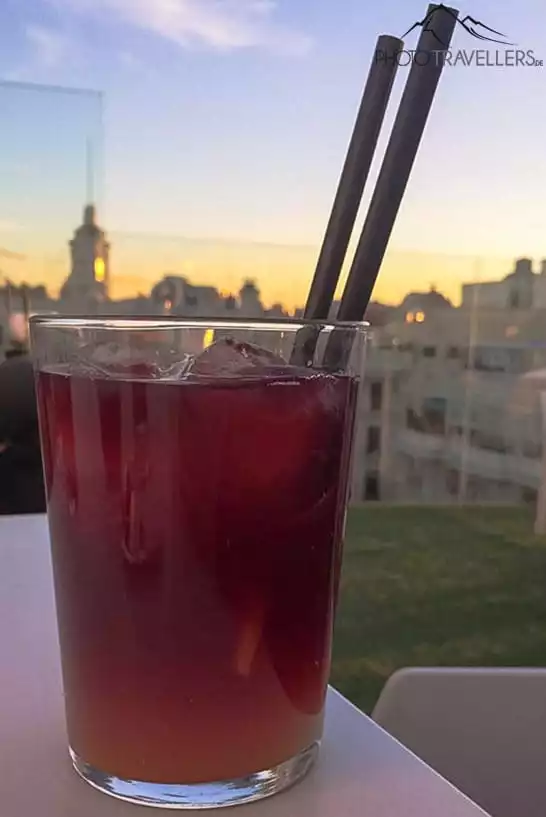
An important part of the Spanish culture that you should not ignore is of course the food, which should have at least as much importance as the sights presented here. So here are some of my favorite dishes and drinks that you should definitely try.
For breakfast in Spain, people often eat pan con tomate, a typical dish from Catalan cuisine. It is a piece of toasted bread or baguette with tomato and olive oil and tastes great with a café con leche (latte) and a freshly squeezed zumo de naranja (orange juice). This combo is available in many cafes for about 4 euros.
Also very typical and delicious is the tortilla – not to be confused with the Mexican flatbread – which comes in thousands of variations. The classic tortilla española is a kind of omelet and consists of potatoes, eggs, and onions. It’s eaten either warm with a knife and fork, as a small tapa with possible side dishes, or on a sandwich.
Speaking of sandwiches, typical of Madrid is the Bocadillo de Calamares, a baguette with fried squid rings. Around the Plaza Mayor, there are numerous bars and restaurants that offer this specialty.
It’s also impossible to imagine Madrid without chocolate con churros – a thick drinking chocolate in which you dip the deep-fried churros or the larger porras. In Spain, people eat this snack for breakfast, especially after partying. However, the churros con chocolate are available around the clock at Madrid’s most famous and oldest – they have been served here since 1894 – Churrería San Ginés. The small store is located on a side street between Puerta del Sol and Ópera squares.
Finally, a typical drink, the Tinto de Verano, which means summer red wine in English. It’s made up of dry red wine, the local lemonade Gaseosa, a dash of vermouth, and lots of ice cubes and is a super tasty alternative to the famous Sangría.
Cheap food and drink in Madrid – the best restaurants and bars in the city
“Such a big city like Madrid, it must be expensive!” – I often got to hear this sentence before I left. But that doesn’t have to be true, because it all depends on where you go. There are definitely typically Spanish, affordable restaurants and bars in Madrid, of which I want to introduce you to my favorites here.
My first tip is Ojalá in the hipster district of Malasaña. There you can get a super delicious breakfast until 8 pm and a great white sangría. If the weather is bad, just have a look in the basement of the restaurant – it’s filled with sand and you feel like you’re at a beach bar! Also in Malasaña, right next to the Tribunal metro station, is Madrid Madriz. They serve the typical Spanish tapas and they really taste great there! There is a bar on the first floor, just go upstairs for the tables to eat.
The Alhambra restaurant is very close to Puerta del Sol – but despite the central location, it’s authentically Spanish here and you almost only meet locals. Also near Puerta del Sol is the small traditional restaurant Casa Labra, founded in 1860 and recommended to me by my Spanish professor in Madrid.
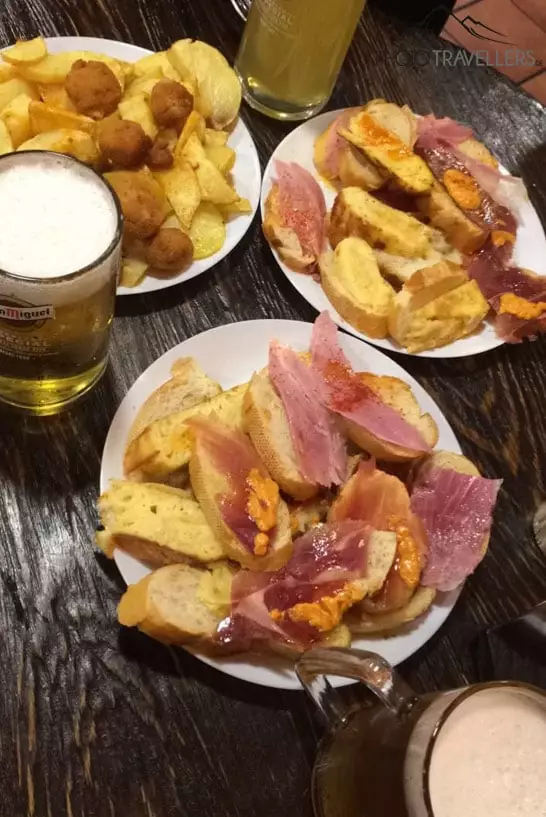
For the small hunger in between, I recommend the Museo de Jamón, which means ham museum in English. However, it is not a museum but a small restaurant chain where there are many sandwiches and other offers. I recommend the croissant mixto, which is topped with ham and cheese.
A much larger fast food chain with branches on every corner is 100 Montaditos, which means 100 appetizers. They actually have 100 different, small, sandwiches, as well as salads, chips, and other side dishes. On Wednesdays and Sundays, with a few exceptions, the entire menu costs just one euro. To order, a slip of paper with the numbers of the appetizers you want must be filled out and either handed in at the cash register or read aloud. Perfect practice for learning the numbers in Spanish!
For the evening, El Tigre del Norte on Calle Hortaleza is a real insider tip. Here you just order a drink right when you walk in – and get a plate full of delicious food for free!
Tip: If you don’t want to miss paella, even though it’s not a typical Madrid dish, try Arrocería Daniela. This restaurant is within walking distance of Puerta del Sol and has a great selection of paella variations that taste like you’re in Valencia.
Here’s what else you can do in Madrid
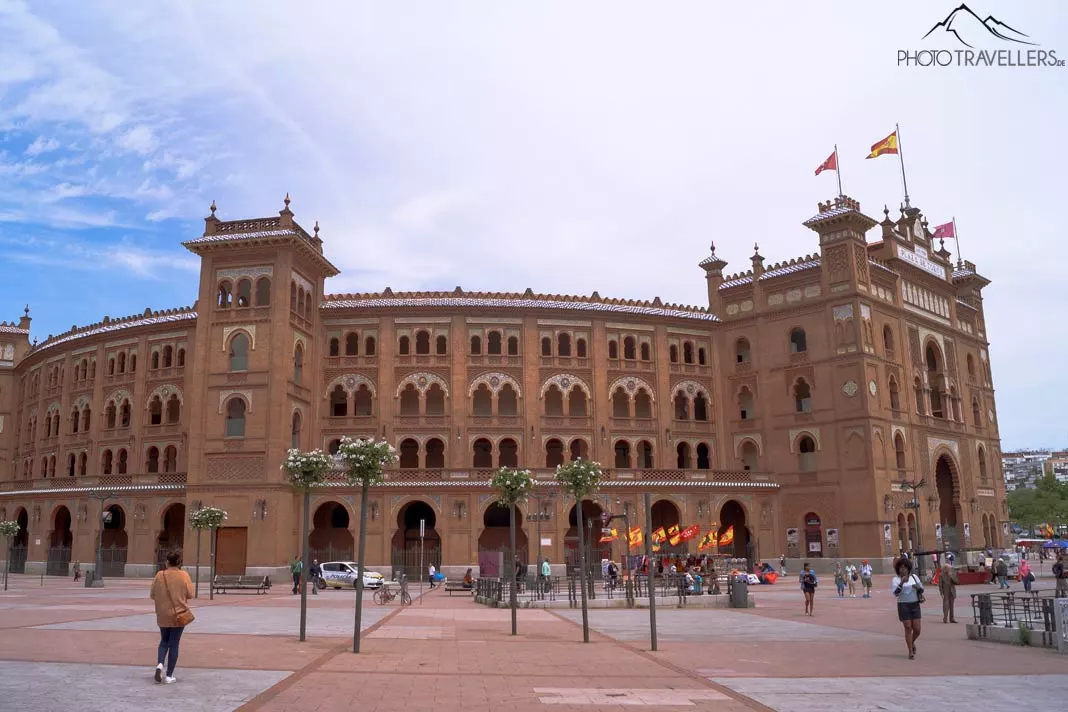
Of course, the top ten sights aren’t all Madrid has to offer. There are a few more attractions that didn’t make the list but are still definitely worth a visit. These include, for example, the Botanical Gardens, located between the Retiro and the Prado Museum.
If you are interested in the Spanish tradition of bullfighting, you should stop by the arena called Plaza de Toros de las Ventas. There is a museum there and guided tours of the structure. You can also still experience real bullfights here – they take place daily from mid-May to early June, when the Feria de San Isidro is celebrated in honor of Madrid’s city saint, Isidore. From an ethical point of view, however, I can’t recommend bullfights.
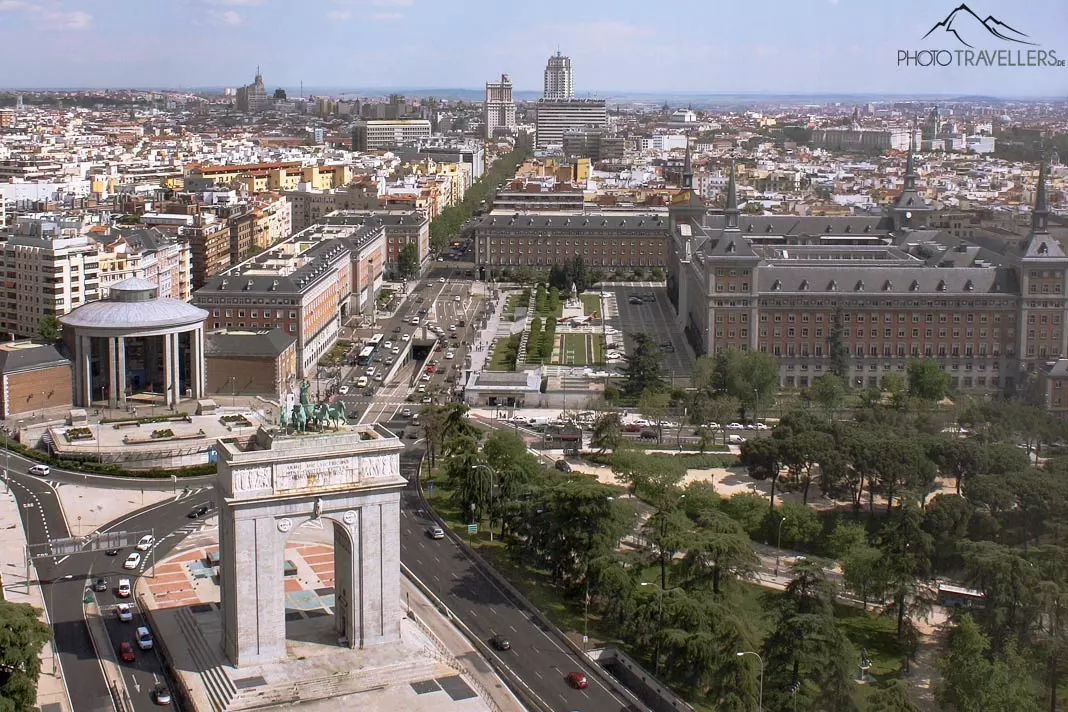
For adrenaline junkies, I recommend the Parque de Atracciones amusement park in the Casa de Campo park with countless great rides. This is not for the faint of heart – but a must for everyone is the Rastro, a mixture of flea market and normal market, which stretches from the metro station La Latina to Puerta de Toledo and takes place every Sunday morning. Attention: be sure to take care of your bags, it’s usually very busy here.
Finally: a really great view of the city is from the Faro de Moncloa, an old lighting tower. A glass elevator takes visitors up to a closed viewing platform 92 meters above the ground – admission costs 3 euros.
Tip: If you’re in Madrid at Christmastime, stop by the Protestant Peace Church near Plaza de Colón for a fun visit – there’s a small German Christmas market here on the first weekend of Advent, with bratwurst, mulled wine, and other treats.
Day trips from Madrid
If you are in Madrid for a longer period of time and have already seen all the famous sights, consider taking a day trip. There are many great destinations around the city. These include surrounding cities like Alcalá de Henares, Toledo, Segovia or Ávila but also great country castles like the Palace of Aranjuez and La Granja de San Ildefonso.
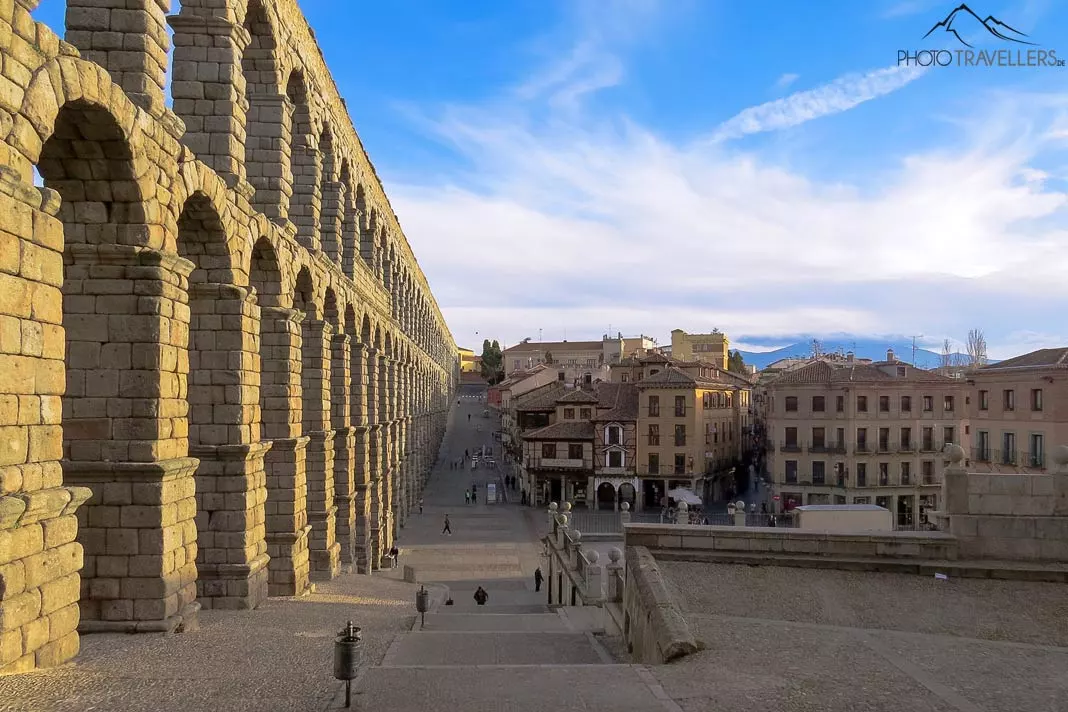
All of them are only about an hour away from Madrid, as well as the monastery of El Escorial. If you feel like a little hike, you should take a closer look at the Laguna de Peñalara, a small lake in the great scenery of the Sierra de Guadarrama mountain range. In winter you can even ski here, as in the ski resort Puerto de Navacerrada.
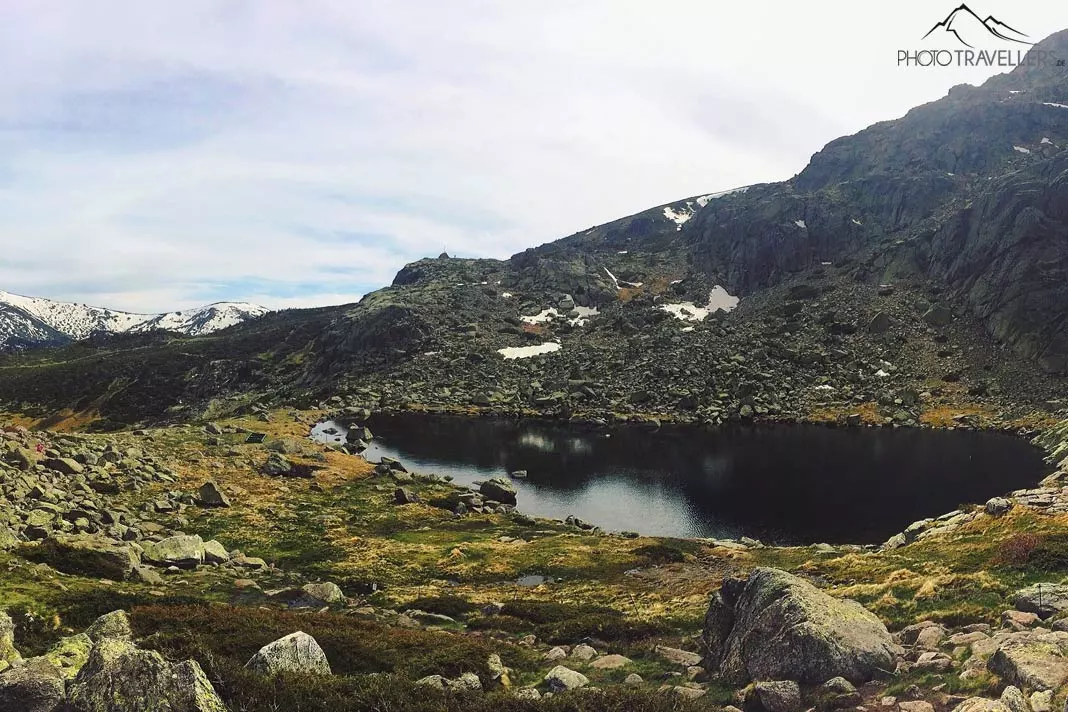 Great hike to the Laguna de Peñalara
Great hike to the Laguna de Peñalara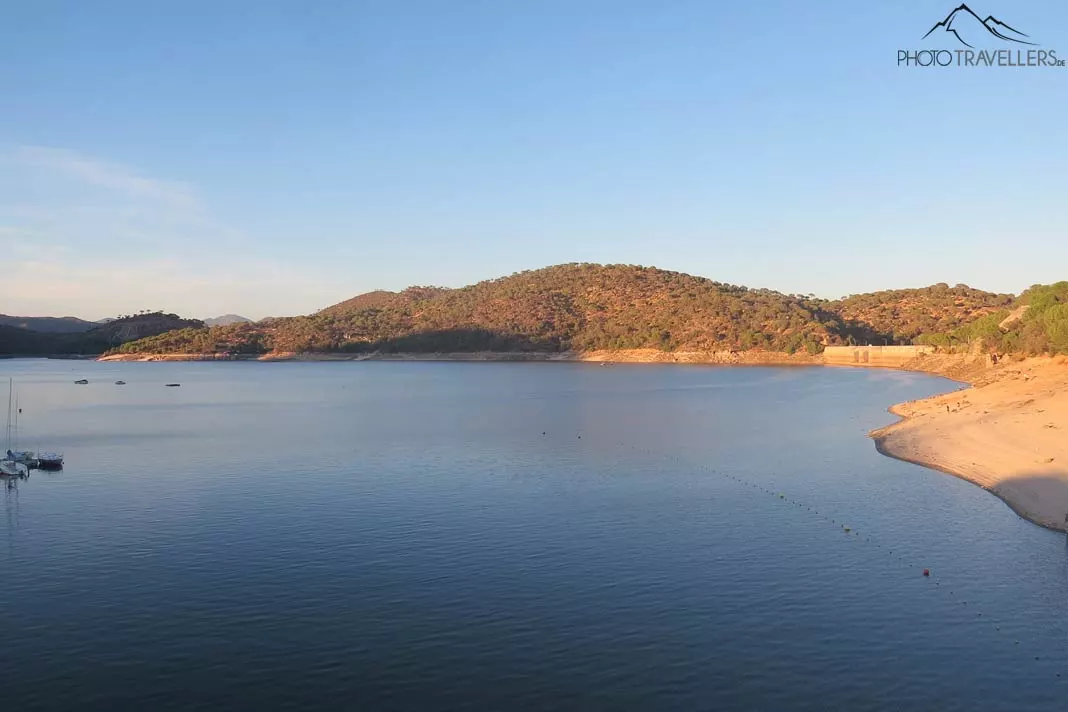 The reservoir Embalse de San Juan is ideal for swimming
The reservoir Embalse de San Juan is ideal for swimmingIf you prefer sunbathing and swimming, you can visit the reservoir Embalse de San Juan. Even in October, you can still go into the water here.
Arrival and transportation in Madrid
How to get from the airport to the city
The Aeropuerto Adolfo Suárez Madrid-Barajas is one of the largest commercial airports in Europe and an important hub for flights to Latin America. From here, buses, metros, and cabs go to the center of the capital. Various bus lines take you into the city center for 1.50 euros – a special express bus is faster in the city center but costs five euros.
The most sensible option is probably a tourist card, which allows you to use the metro and buses (more information). This also eliminates the airport surcharge of three euros that you would otherwise have to pay on the metro. For cabs from the airport to the city, there is a flat rate of 30 euros.
Getting around Madrid
In addition to the metro and buses, the typical hop-on-hop-off tourist bus is also a good alternative for getting around the city. There are two routes – one historic and one modern – and tickets cost 21 euros for one day or 25 euros for two consecutive days. Those who want to be more sporty can use the BiciMAD service – electric bikes can be rented at more than 165 docking stations throughout the city. But: to be able to register for the service, 150 euros are blocked as a deposit on the credit card when issued at the machine. After returning the bikes to any station and paying for the time of use, the amount will be unlocked.
Where to stay in Madrid – the best tips
The absolute Insta-hotspot is the Hotel Riu Plaza España (check prices here*). In addition to a kind of Insta-lounge, where you can take awesome photos with a flower wall with gorgeous views, the hotel also has a roof terrace with a skywalk. Perfect for photos. But be careful. There you will meet many people who want to take stylish photos.
The 3-star Hostal Madrid (check rates here*), for example, is located right between the central squares Puerta del Sol and Plaza Mayor and has very good reviews. The one-star Hostal Enebral (check rates here*) is a very affordable alternative in the lovely Malasaña district, a ten-minute walk from Gran Vía.
The 3-star Room Mate Óscar (check rates here*) is a chic hotel in the LGBTQ neighborhood of Chueca, just a stone’s throw from Gran Vía, and also boasts a super roof terrace with mega views. Also in the Gran Vía directly there are some hotels with great roof terraces, which are of course rather in the higher price ranges to find. These include, for example, the Vincci The Mint (check prices here*), a 4-star designer hotel, on whose terrace there is even a mint-green food truck.
You can find great private vacation rentals on Airbnb, for example, this beautiful apartment near the Diego de León metro station, which is well connected with three different lines.
Facts and figures about Madrid
- Excluding suburbs, Madrid has about 3.2 million inhabitants and is the third largest city in the EU after London and Berlin
- The metropolitan region of Madrid even has almost seven million inhabitants and is one of the largest metropolises in Europe
- Since June 19, 2014, Felipe VI from the Bourbon-Anjou dynasty is King of Spain and thus head of state of the country
- In Madrid, you can visit parts of the Berlin Wall: in the Parque de Berlín and in the Parque Europa
- According to the Guinness Book of Records, Sobrino de Botín on Calle Cuchilleros is the oldest restaurant in the world still in operation – it opened in 1725

